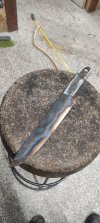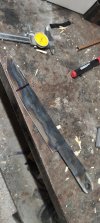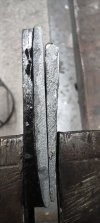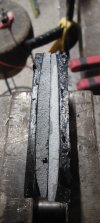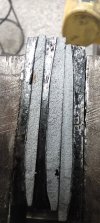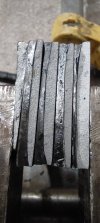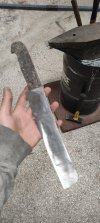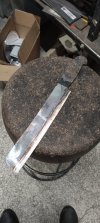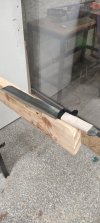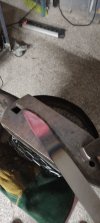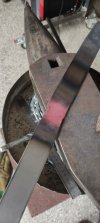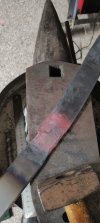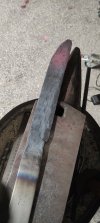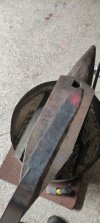Tony Mont
Knifemaker / Craftsman / Service Provider
- Joined
- Apr 15, 2018
- Messages
- 1,478
Hello everybody!
Enough years have passed and I'm eligible to test for my journeyman stamp with the American Bladesmith Society (also known as ABS). This thread is meant to be educational for everybody, also, it will be a fun experience to keep a record of the whole process.
Now, without further adieu, this is how everything began. My forging experience is limited and I'm still learning as I go along. I've forged knives in the past but that doesn't make me an expert.
Since my workshop cannot accommodate a propane forge, I had to find an alternative. My solution to the problem was an induction forge.
It's a lovely and really efficient tool (with the proper coils). Obviously, it has its drawbacks but I will have to make do with the tools I have to my disposal.
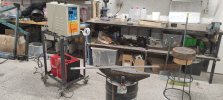
It's been a while since the last time I forged a knife, hence this atrocity of a blade. As a first step, I want forge a blade, do a mock up test and see where I have to improve. My plan for this blade was to keep it simple and do a competition style chopper. The steel of choice is 1084 at 5mm thick.
I forged a rough profile, some distal taper and the bevels and moved forward with the heat treatment.

I wrapped the blade into stainless steel foil while doing my thermo cycles to avoid extreme oxidation.
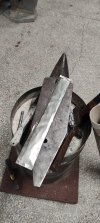
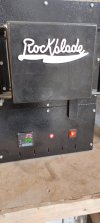
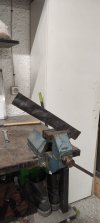
I followed this heat treatment protocol:
1) 1600F-870C for 15 minutes and air cool
2) 1450F-787C for 15 minutes and air cool
3) 1380F-748C for 30 minutes and let it cool overnight in the oven
4) Aus temp 1500F-815C for 10 minutes and quenched in parks 50 oil
5) 2x2hours temper at 400F-200C
I've had a warp in the blade which I corrected with an old masonry bit. A carbide hammer would have been a better option but I haven't made one yet.

With the warp corrected, I cleaned the edge to fresh steel and started the final grind. This is when I decided to grind in a tip, I had a small cold shut near the edge which I ground off.


With a tray full of wet sand, I tempered the spine to a higher temperature.
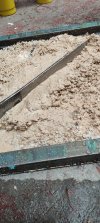
To be continued...
Enough years have passed and I'm eligible to test for my journeyman stamp with the American Bladesmith Society (also known as ABS). This thread is meant to be educational for everybody, also, it will be a fun experience to keep a record of the whole process.
Now, without further adieu, this is how everything began. My forging experience is limited and I'm still learning as I go along. I've forged knives in the past but that doesn't make me an expert.
Since my workshop cannot accommodate a propane forge, I had to find an alternative. My solution to the problem was an induction forge.
It's a lovely and really efficient tool (with the proper coils). Obviously, it has its drawbacks but I will have to make do with the tools I have to my disposal.

It's been a while since the last time I forged a knife, hence this atrocity of a blade. As a first step, I want forge a blade, do a mock up test and see where I have to improve. My plan for this blade was to keep it simple and do a competition style chopper. The steel of choice is 1084 at 5mm thick.
I forged a rough profile, some distal taper and the bevels and moved forward with the heat treatment.

I wrapped the blade into stainless steel foil while doing my thermo cycles to avoid extreme oxidation.



I followed this heat treatment protocol:
1) 1600F-870C for 15 minutes and air cool
2) 1450F-787C for 15 minutes and air cool
3) 1380F-748C for 30 minutes and let it cool overnight in the oven
4) Aus temp 1500F-815C for 10 minutes and quenched in parks 50 oil
5) 2x2hours temper at 400F-200C
I've had a warp in the blade which I corrected with an old masonry bit. A carbide hammer would have been a better option but I haven't made one yet.

With the warp corrected, I cleaned the edge to fresh steel and started the final grind. This is when I decided to grind in a tip, I had a small cold shut near the edge which I ground off.


With a tray full of wet sand, I tempered the spine to a higher temperature.

To be continued...

